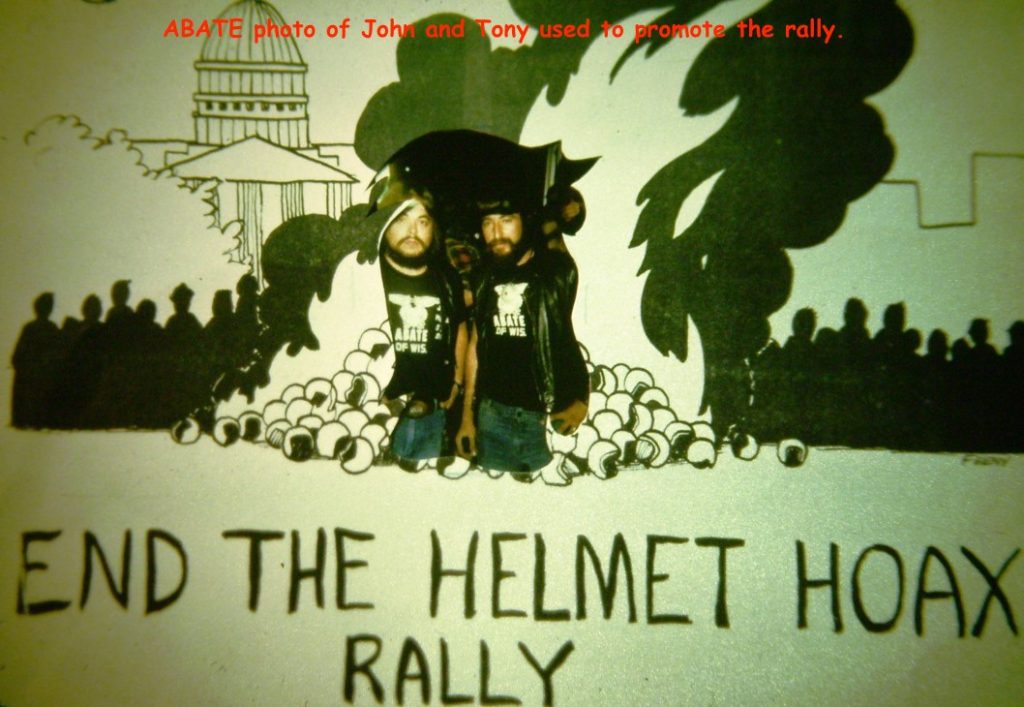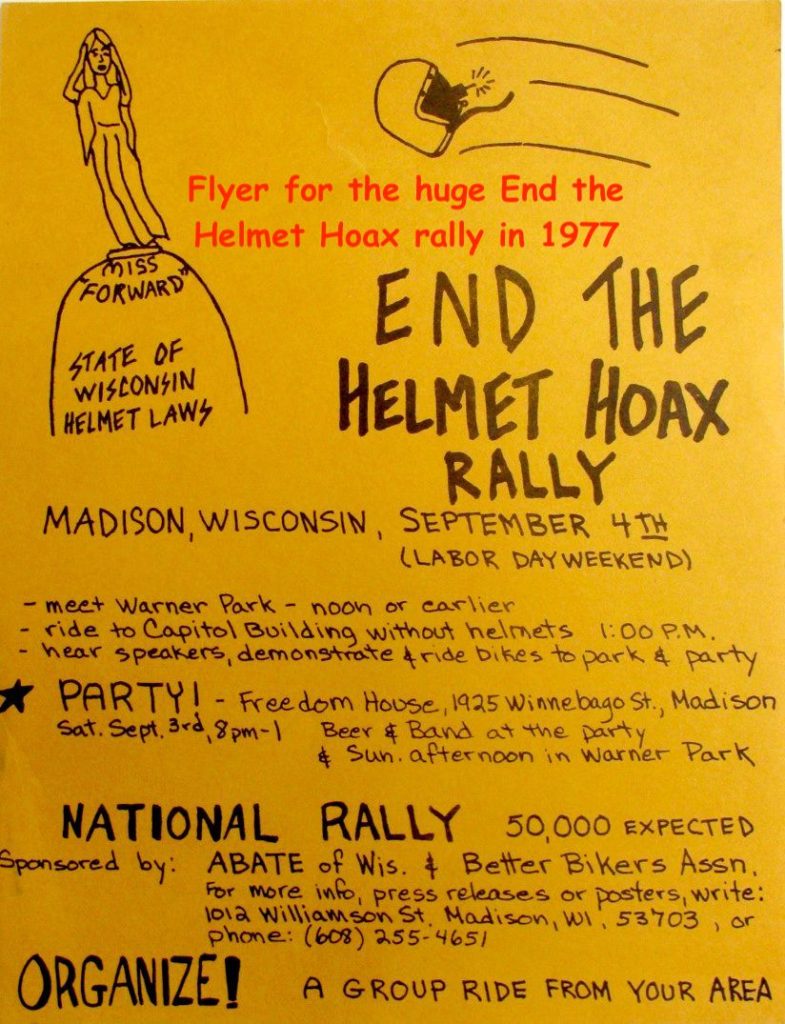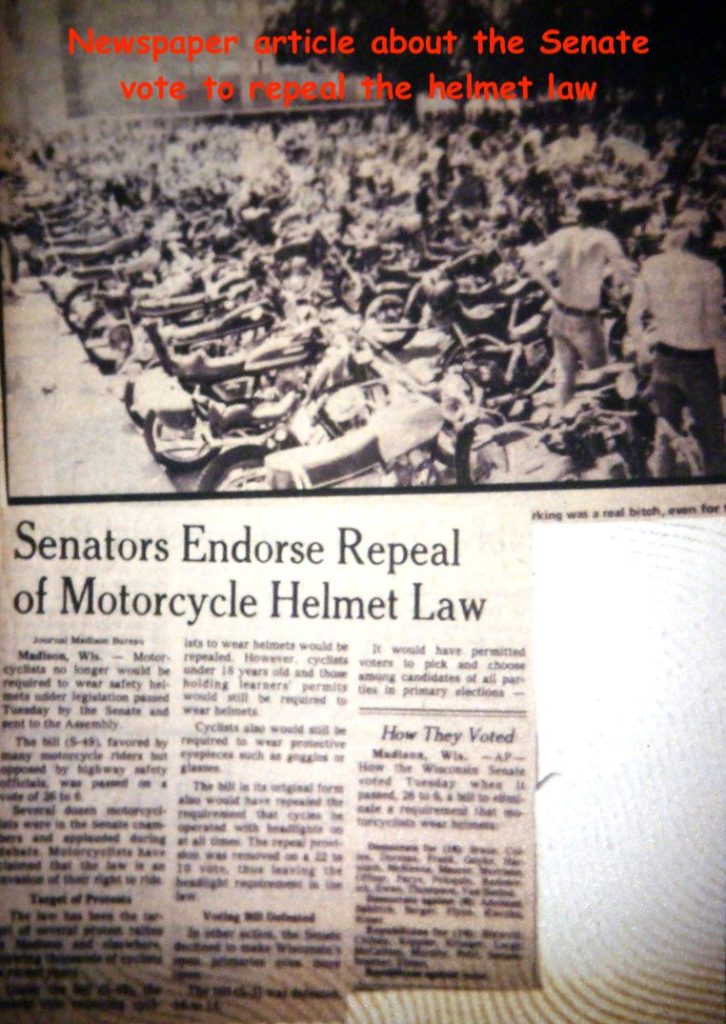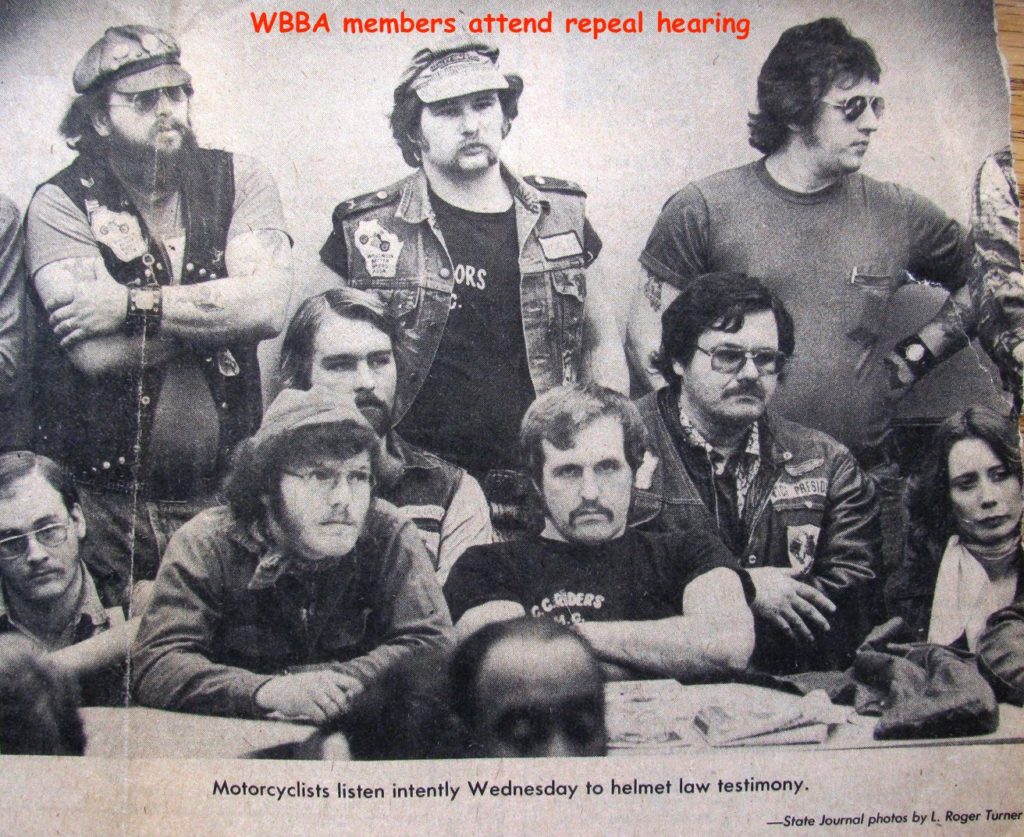Repeals, Disappointment, Protest, distinguish 1977 as pivotal year:
In 1977 we were confident our lobby efforts and past rallies would result in repeal of our mandatory helmet law. The power of the federal DOT to blackmail states was taken away in 1976, thanks to Rep. Stuart McKinney and the Huns MC of Connecticut and member Papa Pittsley. The states claimed safety was the reason for the helmet mandate, but once the federal yoke of blackmail was removed, it was a different story. Here’s the scorecard after the 1976 victory over blackmail:
Alaska, Arizona, Iowa, Kansas, Louisiana, Oklahoma, and Connecticut repeal their helmet laws in 1976. California and Illinois never buckled under the federal threat, and remained free. Maine, Minnesota, Montana, New Mexico, South Carolina and Wyoming repeals become effective in 1977. Seven other states had repeals pending or repeals that failed by veto. In Wisconsin we were certain our efforts would pay off in 1977.
February 9, 1977 was the first public hearing on repeal before the Senate Commerce Committee. We thought we had this under control, since SB49 was sponsored by Senator Ronald Parys, Chairperson of the committee. Then Dick Smith of the WBBA learned that the feds were flying in Lewis Buchanan, U.S. Department of Transportation, to testify against repeal. WBBA and ABATE agreed to drop fighting the “lights on” provision of the bill, concentrating only on the helmet repeal. But the federal government sending a hot-shot to testify against repeal signaled trouble. We got our phone tree communication going (no emails or cell phones back then) and when the NHTSA expert Buchanan entered the hearing room, he saw 300 bikers staring at him in a not so friendly way. We brought in our own expert, Ed Armstrong, ABATE of Illinois, an engineer who testified with professionalism and had many charts and diagrams to back up his presentation of why mandatory helmets were not the solution to reducing injury and deaths. As expected, Buchanan testified with the usual statistics and claims NHTSA was famous for, but when pressed by Senator Parys to provide documentation for his claims, he had none. Statistics without documentation are not compelling, at least to Parys. Tony Sanfelipo, through manipulation of the speaking order slips, was able to wrangle a speaker’s position right after Buchanan. The NHTSA expert passed himself off as a fellow rider, explaining he rode to work every day. Thanks to ABATE of New York, we learned that Buchanan was “ordered to learn how to ride” and was furnished a 450 cc Honda, courtesy of NHTSA. Yes, he rode to work every day, all five miles each way. The gathering laughed and applauded when Tony revealed these facts. He also refuted most of the statistics Buchanan offered and had documentation and hand-outs, courtesy of the AMA, to support his testimony about increased broken necks with helmet use in New York, and the reduction in fatalities after repeal in several states (based on ratio of deaths and increased registrations).
WBBA member from Black Earth, Elmer Tiegs, offered a dynamic treatise on constitutional rights, which was very compelling. Closing out the show, of course, was Dick Smith of the WBBA. His dry wit and sarcasm humiliated both NHTSA and Buchanan and was met by laughter and applause from those in attendance. We knew we won the debate at this hearing.
In April, 1977, the Senate voted and passed the repeal bill by a vote of 26-6 with one absent (there are 33 members of the Senate).
Meanwhile, Representative John Plewa continued to stall a hearing before the Assembly. He was asking for a two-year study of the states that had already repealed the law. This was a delaying tactic and we were not going to stand for it. With pressure from lobbying and a letter writing campaign, we were able to get a hearing in the Assembly in May on AB222. Plewa insisted that we have documentation for any claims we might present during testimony, although he did not require the same from those testifying in opposition of repeal. Even with all his attempts to scuttle the bill, we were able to get it out of committee, although unlike the Senate moving the bill to the floor for a vote with a favorable recommendation, AB222 moved out with no recommendation.
We were more than concerned about the Assembly vote on the bill, especially since then governor Patrick Lucey had vowed to veto the bill if it passed. Then, as if an omen of good fortune, President Jimmy Carter appointed Lucey as Ambassador to Mexico. Our greatest nemesis was gone. We were sure we had enough votes in the Assembly for passage, so it seemed repeal in Wisconsin was eminent. Then, as suddenly as good fortune had smiled on us, disaster struck. Plewa’s manipulations to stall the Assembly version of repeal paid off. It was thought the vote in the Assembly wouldn’t take place until September, so Dick Smith called for one last rally, one last nail in the coffin of the mandatory helmet law. He billed this rally, the “End the Helmet Hoax” rally. We needed to make a dynamic statement about how we felt about the mandatory helmet law, especially since Lucey’s replacement, acting governor Martin Schrieber, also vowed to veto any repeal of the law. Smith set the rally for September 4, 1977. All five of the previous rallies were peaceful and the grounds of the Capitol were cleaner after the rallies than when we arrived, thanks to the WBBA network of volunteers and club members. To stress the importance of this rally, he spoke at a press conference and told the media that the September rally would be the “last peaceful” rally we would hold. He said nothing else. The media and the public were left guessing whether he meant this would be the last rally, period, or if it were just the last peaceful rally. Smith was a master of saying less and implying more.
At this same time, ABATE was going through an internal struggle on the national level. There was mixed feelings about an ABATE national organization, who would run it, where the headquarters would be, and how it would work. A meeting was scheduled for Lake Perry, Kansas, September 4, 1977, the same day as our End the Helmet Hoax rally. ABATE of Wisconsin tried unsuccessfully to have the ABATE national meeting moved to Madison, during what we expected to be our largest rally ever. After consulting with Charlie Williams of ABATE of Missouri, the powers that be decided to stay in Kansas for the meeting. This was a showdown between Easyriders Magazine and the various state ABATE leaders on how to form a national group. More on that later. For now, ABATE of Wisconsin was busy meeting with the WBBA and planning what would turn out to be the largest gathering of bikers to protest the mandatory helmet law anywhere in the country. It was hoped this rally would prompt a vote on repeal on the floor of the Assembly. Next installment, “Madness, Mayhem and Mysticism” in Madison.





